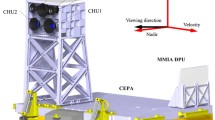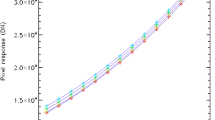Abstract
We present THERMAP, a mid-infrared spectro-imager for space missions to small bodies in the inner solar system, developed in the framework of the MarcoPolo-R asteroid sample return mission. THERMAP is very well suited to characterize the surface thermal environment of a NEO and to map its surface composition. The instrument has two channels, one for imaging and one for spectroscopy: it is both a thermal camera with full 2D imaging capabilities and a slit spectrometer. THERMAP takes advantage of the recent technological developments of uncooled microbolometer arrays, sensitive in the mid-infrared spectral range. THERMAP can acquire thermal images (8–18 μm) of the surface and perform absolute temperature measurements with a precision better than 3.5 K above 200 K. THERMAP can acquire mid-infrared spectra (8–16 μm) of the surface with a spectral resolution Δλ of 0.3 μm. For surface temperatures above 350 K, spectra have a signal-to-noise ratio >60 in the spectral range 9–13 μm where most emission features occur.












Similar content being viewed by others
References
Barucci, M.A., et al.: MarcoPolo-R near earth asteroid sample return mission. Exp. Astron. 33, 645 (2012)
Brageot, E., et al.: Experimental study of an uncooled microbolometer array for thermal mapping and spectroscopy of asteroids. Exp. Astron. 38, 381 (2014)
Brunetto, R., et al.: Modeling asteroid surfaces from observations and irradiation experiments: the case of 832 Karin. Icarus 184, 327 (2006)
Brunetto, R., et al.: Space weathering of silicates simulated by nanosecond pulse UV excimer laser. Icarus 180, 546 (2006)
Brunetto, R., et al.: Reflectance and transmittance spectra (2.2 2.4 μm) of ion irradiated frozen methanol. Icarus 175, 226 (2005)
Chapman, C.R.: Space weathering of asteroid surfaces. Annu. Rev. Earth Planet. Sci. 32, 539 (2004)
Davidsson, B.J.R., et al.: Thermal inertia and surface roughness of Comet 9P/Tempel 1. Icarus 224, 154 (2013)
Davidsson, B.J.R., et al.: Interpretation of thermal emission. I. The effect of roughness for spatially resolved atmosphereless bodies. Icarus 252, 1–21 (2015)
Delbo, M., et al.: Thermal fatigue as the origin of regolith on small asteroids. Nature 508, 233 (2014)
Dohlen, K., et al.: Optical designs for the Rosetta narrow-angle camera. Opt. Eng. 35, 1150 (1996)
Fulvio, D., et al.: Space weathering of Vesta and V-type asteroids: new irradiation experiments on HED meteorites. Astron. Astrophys. 537, L11 (2012)
Groussin, O., et al.: The temperature, thermal inertia, roughness and color of the nuclei of Comets 103P/Hartley 2 and 9P/Tempel 1. Icarus 222, 580 (2013)
Groussin, O., et al.: Surface temperature of the nucleus of Comet 9P/Tempel 1. Icarus 187, 16 (2007)
Gundlach, B., Blum, J.: A new method to determine the grain size of planetary regolith. Icarus 223, 479–492 (2013)
Harris, A.W., Lagerros, J.S.V.: Asteroids in the thermal infrared. Asteroids III, pp. 205–218. University of Arizona Press, Tucson (2002)
Hiesinger, H., Helbert, J., Mertis Co-I Team: The mercury radiometer and thermal infrared spectrometer (MERTIS) for the BepiColombo mission. Planet. Space Sci. 58, 144 (2010)
Hiroi, T., et al.: Developing space weathering on the asteroid 25143 Itokawa. Nature 443, 56 (2006)
Mainzer, A., et al.: Preliminary results from NEOWISE: an enhancement to the wide-field infrared survey explorer for solar system science. Astrophys. J. 731, 53 (2011)
Marchi, S., et al.: Space weathering of near-earth and main belt silicate-rich asteroids: observations and ion irradiation experiments. Astron. Astrophys. 443, 769 (2005)
Martin-Hernando, Y., et al.: Microbolometer characterization with the electronics prototype of the IRCAM for the JEM-EUSO mission. SPIE proceedings 9143, space telescopes and instrumentation. Op Infrared, and Millimeter Wave. 28, 13 (2014)
Maturilli, A., et al.: The Berlin emissivity database (BED). Planet. Space Sci. 56, 420 (2008)
Morbidelli, A., Vokrouhlicky, D.: The Yarkovsky-driven origin of near-earth asteroids. Icarus 163, 120 (2003)
Müller, T.G.: Thermophysical analysis of infrared observations of asteroids. Meteorit. Planet. Sci. 37, 1919 (2002)
Nakamura, T., et al.: Itokawa dust particles: a direct link between S-type asteroids and ordinary chondrites. Science 333, 1113 (2011)
Noguchi, T., et al.: Incipient space weathering observed on the surface of Itokawa dust particles. Science 333, 1121 (2011)
Pieters, C.M., et al.: Space weathering on airless bodies: resolving a mystery with lunar samples. Meteorit. Planet. Sci. 35, 1101 (2000)
Price, S.D., et al.: Thermal profiles of the eclipsed moon. Adv. Space Res. 31, 2299–2304 (2003)
Rozitis, B., Green, S.F.: Directional characteristics of thermal infrared beaming from atmosphereless planetary surfaces – A new thermophysical model. Mon. Not. R. Astron. Soc. 415, 2042 (2011)
Rozitis, B., Green, S.F.: The influence of rough surface thermal-infrared beaming on the Yarkovsky and YORP effects. Mon. Not. R. Astron. Soc. 423, 367 (2012)
Rozitis, B., Green, S.F.: The influence of global self-heating on the Yarkovsky and YORP effects. Mon. Not. R. Astron. Soc. 433, 603 (2013)
Rubincam, D.P.: Radiative spin-up and spin-down of small asteroids. Icarus 148, 2 (2000)
Saito, J., et al.: Detailed images of asteroid 25143 Itokawa from Hayabusa. Science 312, 1341 (2006)
Strazzulla, G., et al.: Spectral alteration of the meteorite Epinal (H5) induced by heavy ion irradiation: a simulation of space weathering effects on near-earth asteroids. Icarus 174, 31 (2005)
Trilling, D.E., et al.: ExploreNEOs. I. I. Description and first results from the warm Spitzer near-earth object survey. Astron. J. 140, 770–784 (2010)
Vernazza, P., et al.: High surface porosity as the origin of emissivity features in asteroid spectra. Icarus 221, 1162 (2012)
Vernazza, P., et al.: Asteroid (21) Lutetia as a remnant of Earth’s precursor planetesimals. Icarus 216, 650 (2011)
Vernazza, P., et al.: Plausible parent bodies for enstatite chondrites and mesosiderites: implications for Lutetia’s fly-by. Icarus 202, 477 (2009)
Vernazza, P., et al.: Solar wind as the origin of rapid reddening of asteroid surfaces. Nature 458, 993 (2009)
Vernazza, P., et al.: Asteroid colors: a novel tool for magnetic field detection? the case of Vesta. Astron. Astrophys. 451, L43 (2006)
Acknowledgments
The contribution from France to the THERMAP instrument was funded by the Centre National d’Etudes Spatiales (CNES). The contribution from Spain to the THERMAP instrument was funded by the Spanish “Ministerio de Economia y Competitividad” projects AYA2011-29489-C03-02 and AYA2012-39115-C03- 03. M. Delbo acknowledges support from the French “Agence Nationale de la Recherche” (ANR-SHOCKS).
Author information
Authors and Affiliations
Corresponding author
Rights and permissions
About this article
Cite this article
Groussin, O., Licandro, J., Helbert, J. et al. THERMAP: a mid-infrared spectro-imager for space missions to small bodies in the inner solar system. Exp Astron 41, 95–115 (2016). https://doi.org/10.1007/s10686-015-9475-9
Received:
Accepted:
Published:
Issue Date:
DOI: https://doi.org/10.1007/s10686-015-9475-9




